Wildlife Tolerance Level Analysis for Green Projects
Objective of a Wildlife Tolerance Level Analysis
While a distribution analysis allows you to compare current dead wood condition to reference conditions, as represented by the vegetation inventory data, a wildlife tolerance level analysis allows the assessment of how wildlife species are affected by the amount of dead wood across the landscape. The closer the current conditions are to reference conditions the higher the likelihood that adequate habitat is being provided for dead wood associated species and processes. However, some species will be affected differently than others as current conditions depart from reference conditions.
A wildlife tolerance level analysis can be conducted for snags or for down wood.
Project Area vs. Analysis Area
Project areas are usually delineated to encompass an area containing stands to be treated. These areas are usually too small to adequately analyze the impacts of the project on dead wood levels across the landscape. Technically the wildlife data in DecAID can be applied at the stand level. The inventory data in the DecAID Advisor, however, are appropriately used to assess dead wood at the landscape level, not at the smaller stand scale. Any dead wood analysis will be strengthened by using both DecAID data sets.
The DecAID Advisor contains the following discussion on appropriate scale of application of the wildlife and inventory data contained in the advisor:
"The calculated tolerance levels (80%, 50%, 30 %) for wildlife data can be applied to stand-level management. However, we do not advise that a particular tolerance level be applied to all stands across a landscape. Rather, decisions about how to distribute different levels of dead wood across a landscape can be guided by the distribution information from unharvested plots.
When using the inventory data, analysis areas (landscapes or watersheds) should be sufficiently large to encompass the range of variation in wildlife habitat types and structural conditions that occur in the area in which the inventory data were collected (i.e. representative of variation at the sub-regional scale). It is impossible to specify a single minimum size analysis area that is most appropriate to all ecoregions and geographic areas. However, as a general rule-of-thumb we suggest that analysis areas be at least 20 square miles (12,800 acres, 5,120 ha) in size. This coincides with the small end of the range of sizes typical of 5th-field hydrologic [now 10th-field HUC] unit codes (HUCs). The exception would be when managing habitats that are rare at a broad geographic scale, even if they are common at the watershed scale (e.g. recent post-fire habitats). Even at the scale of the 5th-field HUC [now 10th-field HUC] , wildlife and inventory summaries for multiple vegetation conditions will need to be considered in the analysis and planning process."
Snag and down wood levels in the analysis area can be compared against the information from inventory data contained in DecAID only if the area is large enough to allow such a comparison. The analysis area should be large enough to represent the variation in snag habitat and distribution from which the inventory data were collected. If this is not possible, a comparison between the project area and the inventory data may not be appropriate.
Based on the above discussion, a minimum analysis area would include all those 10th field hydrologic units (watersheds) or 12th field hydrologic units (subwatersheds) intersected by the analysis area, if it totals at least 20 square miles (12,800 acres). This "rule-of-thumb" should apply to most projects in green forests (i.e. regeneration harvest, commercial thinning, etc.).
Region-wide Distribution Analysis
Steps 1-4 of a Distribution Analysis have been run for all Forest Service lands in Region 6 using the 2012 GNN data. These data can be used as is and clipped to your forest boundary or watershed. To access the analysis go to the Region-wide Distribution Analysis section of the Links to Useful Information section on the main page of this web site.
The regional Distribution Analysis provides information that can be used in a wildlife tolerance level analysis. This is noted in the individual steps that follow.
Wildlife Tolerance Level Analysis
A wildlife tolerance level analysis allows you to estimate what percent of the landscape provides habitat for varying species at each tolerance level. This analysis can be conducted for snags and down wood. Below are instructions on how to perform a wildlife tolerance level analysis for a project. A snag analysis is outlined; a down wood analysis would follow the same steps.
Step 1:Data Collection: Determine current snag and down wood distribution across the landscape
This step has been completed for the entire region in the Region-wide Distribution Analysis. The region-wide analysis used GNN data circa 2012. The data should be updated for fires or other major disturbances that have occurred since then. See Distribution Analysis link in table 3 of the guide
Supplemental data may need to be used to update the data for disturbances or activities that have occurred since 2012. Here are some examples of survey methods or data that may be available:
- Ground surveys - A good methodology can be found in Bate et al. 1999 http://www.fs.fed.us/pnw/pubs/gtr_425.pdf
- Recent stand exams (caveat - on some forests only merchantable snags were measured, and not all stands have stand exams - they also may not represent a systematic sample of overall conditions).
- FVS - FVS (Forest Vegetation Simulator) can run old stand exam data to project current snag levels. Normalizes data from stand exams taken in different years and puts them into one year.
- GIS mapping of various forest stands based on past management can be used to modify snag and down wood densities as needed. Some examples of possible categories are:
- Data for recent treatments from project implementation can be found in your local FACTS database.
- Roads have been buffered in the Region-wide Distribution Analysis using a regional roads layer. A local roads layer could be used to more accurately buffer roads.
- Developed recreation sites, administrative sites, etc. where hazard tree removal has reduced snag levels based on the local Forest policy. This area can be determined by calculating the distance from each site. The resulting acreage can be assigned a snag density.
- Recent fires create varying densities of snags depending on fire intensity and severity. There are several sources for data on fires. See the Wildfire maps section of the Links to Useful Information section on the main page of this web site.
- Areas of high snag densities due to other disturbances (e.g. insect infestations where high mortality occurred, areas of root rot, etc.). Region 6 conducts annual aerial surveys of insect- and disease-caused mortality and most National Forests should have this information available in their GIS systems. If not, it can be downloaded from the RO Forest Health Protection website (Aerial Survey Data). These data can be used to help determine areas with high levels of mortality. Annual surveys only calculate "new" dead based on changes in foliage color, so there is a need to overlay multiple years of aerial data. Using 5 to 10 years of aerial data may better reflect existing conditions. If you need assistance in interpretation of the data or in converting data to cumulative numbers of dead trees per acre, contact Ben Smith (bsmith02@fs.fed.us)(WA), Bob Schroeter (rschroeter@fs.fed.us)(OR), or Zach Heath (zheath@fs.fed.us) for assistance in interpreting the data appropriately. Forest Service researchers have been field testing the accuracy of the aerial survey data and their preliminary conclusions suggest that surveys underestimate snag levels. At this time, a general "rule of thumb" is to multiply the reported values by 3.
Step 2:Determine Which Species Should be Addressed for This Project
Begin by looking at the wildlife information and data available for the vegetation type being analyzed. The best place to start is under the INTRODUCTION TO AVAILABLE DATA - Wildlife data section of the Summary Narrative for the Vegetation Condition that applies to your analysis area. If there are data available and summarized for dead wood associated MIS species, species of concern, TES species, focal species, or any other species that should be addressed to support the analysis, the Wildlife Tolerance Level Analysis may be considered for the project. For those species which are not represented in the cumulative species curves, additional data may be available that can assist with the analysis. Additional studies will be mentioned in the same section of the Summary Narrative. A more qualitative assessment can be done for those species.
Step 3:Determine What the Tolerance Levels are for the Species
Refer to the Synthesized Data on Snag Density tables under the Data/Snag Density drop down on the left-hand side in DecAID, (e.g. Table PPDF_L.sp-3) to determine snag density tolerance levels. Determine what the snag density is for each wildlife tolerance level for the species being addressed. Develop a table to display this information. Develop a similar table for down wood habitat where data are available.
TIP: Make sure that you are comparing acres to acres or hectares to hectares, as well as inches to inches and cm to cm. See Metric Conversions for English to metric conversion factors.
Example of Wildlife Tolerance Level Analysis
Table 1. Snag densities for wildlife species at 30, 50, and 80 percent tolerance level for snags > 10"dbh. DecAID Table PPDF_L.sp-3.
| Wildlife Species | 30% Tolerance level (#snags/acre) based on wildlife data in DecAID |
50% Tolerance level (#snags/acre) based on wildlife data in DecAID |
80% Tolerance level (#snags/acre) based on wildlife data in DecAID |
|---|---|---|---|
| Black-backed Woodpecker (BBWO) | 2.4 | 13.4 | 28.7 |
| Hairy Woodpecker (HAWO) | 0.0 | 16.7 | 4537 | White-headed Woodpecker (WHWO) | 0.0 | 6.4 | 18.5 |
Table 2. Snag densities for wildlife species at 30, 50, and 80 percent tolerance level for snags > 20"dbh. DecAID Table EMC_L.sp-3.
| Wildlife Species | 30% Tolerance level (#snags/acre) based on wildlife data in DecAID |
50% Tolerance level (#snags/acre) based on wildlife data in DecAID |
80% Tolerance level (#snags/acre) based on wildlife data in DecAID |
|---|---|---|---|
| White-headed Woodpecker (WHWO) | 0.3 | 1.5 | 3.4 |
| Black-backed Woodpecker (BBWO) | 0.0 | 1.4 | 5.6 |
| Cavity-nesting Birds (CNB) | -- | 1.0 | 2.7 |
| Pileated Woodpecker (PIWO) | 3.5 | 7.9 | 18.14 |
| Williamson's Sapsucker (WISA) | 3.0 | 8.3 | 16.1 |
Step 4:Build A "Current Condition" Histogram to Display the Amount of Landscape in Each Wildlife Tolerance Level
For Low or Moderate Risk projects the graphs in the Distribution Analysis spreadsheet templates can be used to assess the affects to wildlife species. Follow the instructions that accompany the spreadsheets.
Wildlife Tolerance Level Analysis using the Distribution Analysis spreadsheet templates
Select the *_Hist&wildlife tab in the DecAID_DistributionAnalysis *.xlsx for the WHT(s) you are assessing. Figure 1 is an example for the EMC WHT. The red boxes can be removed from the template if there is no salvage involved in the project. Boxes for any species not occurring in the analysis area should also be removed from the graph.
Figure 1. Distribution Analysis with wildlife 50% tolerance levels displayed.
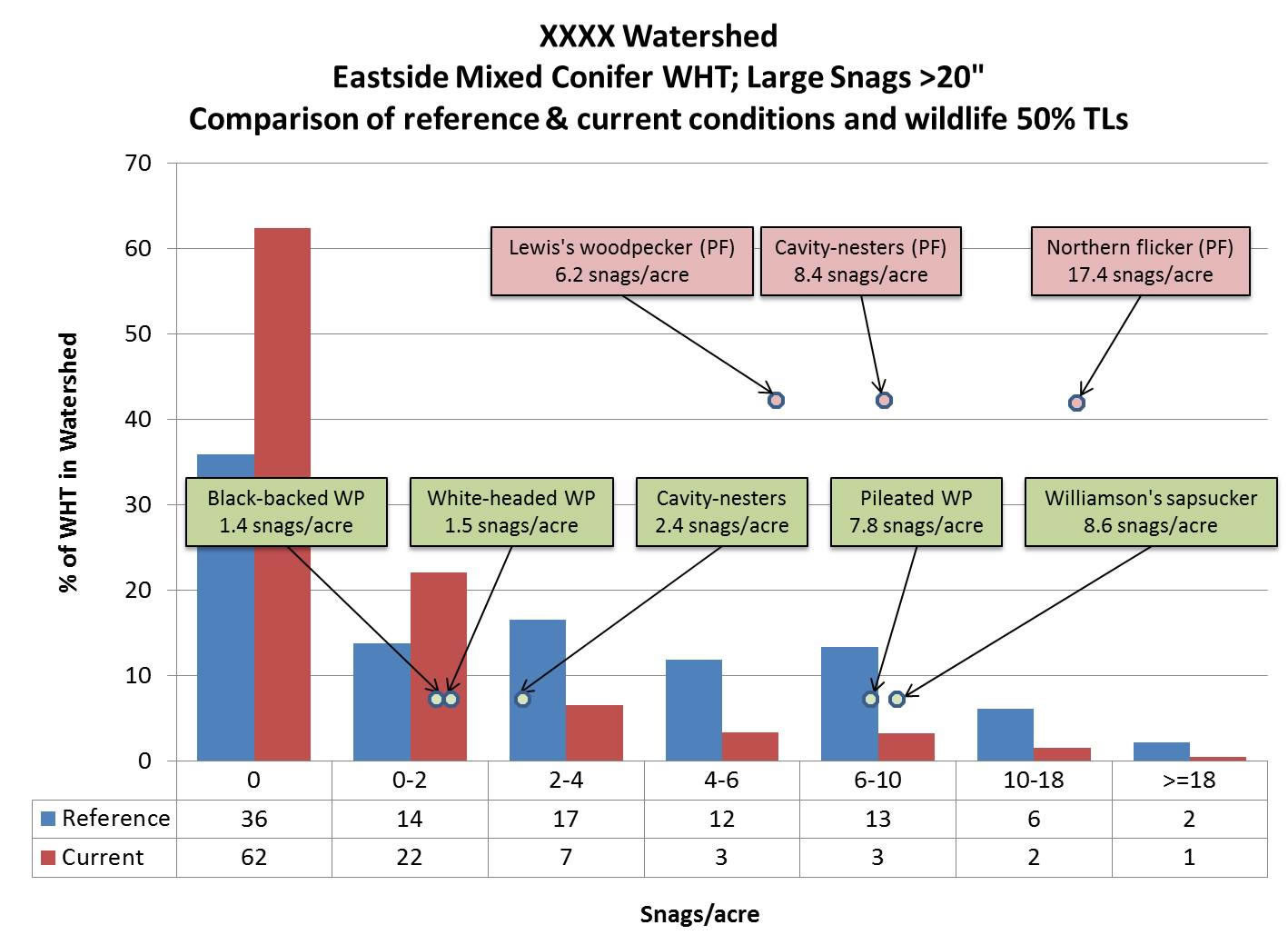
Interpretation
The following conclusions can be inferred from the information in Figure 1 and Table 2:
- Compared to reference conditions, the amount of large snags on the landscape meets the 50% tolerance level for black-backed and white-headed woodpeckers, but not the 80% tolerance level.
- Compared to reference conditions, the amount of large snags on the landscape does not meet the 50% tolerance level for cavity nesters as a group, or the 30%, 50% or 80% tolerance level for pileated woodpeckers or Williamson's sapsuckers, compared to reference conditions.
- The percent of the analysis area in the high density snag classes is lower than reference conditions, and thus is not providing much habitat for post-fire associated species. It is likely that there has not been recent stand-replacing disurbance in the analysis area.
Detailed Wildlife Tolerance Level Analysis
For High Risk projects it is recommended that a more detailed analysis be completed as follows.
Using the map created in Step 1 and the information on tolerance level by species from Step 3, calculate how many acres provide those snag densities and down wood percent cover under current conditions and what percent of the landscape those acres represent. Create a table and/or histogram to display this information.
Acres should just be those within habitat for each individual species. Overlay the species habitat with the snag density data to calculate acres in each tolerance interval.
Table 3. Amount of the analysis area providing snag densities for wildlife species within four different tolerance intervals (0-30%, 30-50%, 50-80%, and 80-100%) for snags >10"dbh (from table 1). Analysis area =15,000 acres.
Table 3. Example of the amount and percent of the analysis area providing snag densities for wildlife species associated with post-fire habitats within four different tolerance intervals (0-30%, 30-50%, 50-80%, and 80-100%) for snags >10"dbh (from table 1). Example Analysis Area =50,000 acres.
| Wildlife Species | Acres (% analysis area) providing habitat at 0-30% tolerance interval | Acres (% analysis area) providing habitat at 30-50% tolerance interval | Acres (% analysis area) providing habitat at 50-80% tolerance interval | Acres (% analysis area) providing habitat at 80-100% tolerance interval |
|---|---|---|---|---|
| White-headed Woodpecker (WHWO) | 5,850 acres (39%) |
5,550 acres (37%) |
2,250 acres (15%) |
1,500 acres (10%) |
| Black-backed Woodpecker (BBWO) | 13,050 acres (87%) |
1,950 acres (13%) |
0 acres (0%) |
0 acres (0%) |
| Cavity-nesting Birds (CNB) | 9,150 acres (61%) |
4,650 acres (31%) |
900 acres (6%) |
300 acres (2%) |
| Long-legged Myotis (LLMY) | 13,500 acres (90%) |
1,500 (10%) |
0 acres (0%) |
0 acres (0%) |
| Pileated Woodpecker (PIWO) | 15,000 acres (100%) |
0 acres (0%) |
0 acres (0%) |
0 acres (0%) |
| Pygmy Nuthatch (PYNU) | 9,150 acres (61%) |
4,650 acres (31%) |
1,200 acres (8%) |
0 acres (0%) |
| Williamson's Sapsucker (WISA) | 15,000 acres (100%) |
0 acres (0%) |
0 acres (0%) |
0 acres (0%) |
It is important to compare the wildlife data to the inventory data to determine what the area is capable of providing in terms of snag habitat. Use the information from the distribution histograms in DecAID or from the Regional Distribution Analysis Spreadsheets.
Figure 2. Percent of landscape that provides habitat for wildlife species at each tolerance interval.
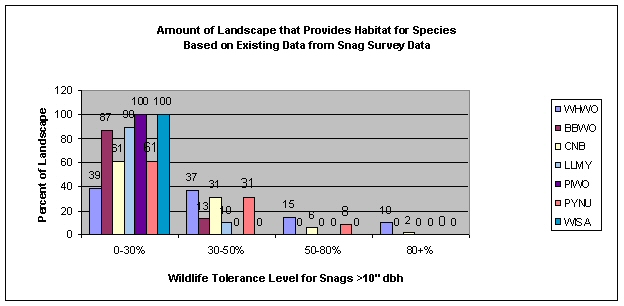
Table 4. Percent of the landscape in the PPDF_L Wildlife Habitat Type in snag density classes (snags>10" dbh). From Figure PPDF_L.inv-1.
| 0 snags/acre | 0-4 snags/acre | 4-8 snags/acre | 8-12 snags/acre | >12 snags/acre | |
|---|---|---|---|---|---|
| Percent of Landscape | 36% | 17% | 18% | 9% | 20% |
Interpretation
The following conclusions about the amount of the analysis area providing wildlife habitat with adequate densities of snags >10" dbh densities can be inferred from the graph in Figure 2 and Tables 3:
- Snag habitat is rare or nonexistent on the landscape at tolerance levels above 50% for all species except the white-headed woodpecker.
- Snag habitat for pileated woodpecker and Williamson's sapsucker is provided only at the 30% tolerance level or less. However, snag densities high enough to provide nesting habitat for these species is very rare in this WHT even under reference conditions.
- Snag habitat for cavity-nesting birds as a group is present in about the same amount as would occur under reference conditions based on unharvested inventory plots.
Step 5:Assess the effect of project on future snag habitat
Even if no snags are being harvested in the project, silvicultural treatments are likely to have an effect on the recruitment of snags in the future. The assessment of effects can be either qualitative or quantitative depending on project risk and magnitude of anticipated effects.
A quantitative assessment is recommended for most projects and can be accomplished by running the Forest Vegetation Simulator (FVS) Fire and Fuels Extension. The analysis will show both future stand structure with associated mortality and dead wood dynamics including snag fall and decay. See Step 5 in the Distribution Analysis document.
A qualitative assessment for small, low risk projects and would involve discussion of effects such as expected reduction or increase in mortality, and impact to size of future snags. For instance it may be that thinning sales will allow creation of snags following sale activities in watersheds depauperate of snags, but may also decrease risk of mortality due to suppression or insect and disease outbreaks and thus suppress snag creation for decades into the future. Thinning to wider spacing may more quickly grow larger green trees that can eventually become (larger) snags, but make sure to discuss the mortality mechanism that will turn the larger trees in to snags in the future. Prescribed burning may reduce dead wood habitat at least in the short term (Bagne et al. 2008).
The sections in DecAID on Insects and Pathogens and the associated tables under the Considerations for Stand Dynamics section of the summary narratives provide a wealth of information on situations which may promote or reduce insects and pathogens in stands. Information on the amount of these agents that can be expected in stands is also available from an analysis of inventory data.
Step 6:Incorporate DecAID Data on size, decay class, etc.
DecAID provides other data on snags and down wood besides snag density:
| Snags | Down wood |
|---|---|
|
|
These data can be used to assist in setting snag and down wood retention guidelines. For example, Figure EMC_PF.sp-1 indicates that at the 80% tolerance level most species use large snags (> 20 inches dbh) for nests. Table EMC_ECB_M.inv-1 indicates that these large snags are rare, making up just 4% of all snags surveyed on the unharvested vegetation inventory plots in this habitat type. This information illustrates the need to retain the largest snags during harvest activities.
Figure EMC_PF.sp-1. Mean height of trees and snags used by wildlife species or groups in Eastside Mixed Conifer Forest Wildlife Habitat Type. Tree heights are weighted means for trees and snags across studies with the same species and tree use.
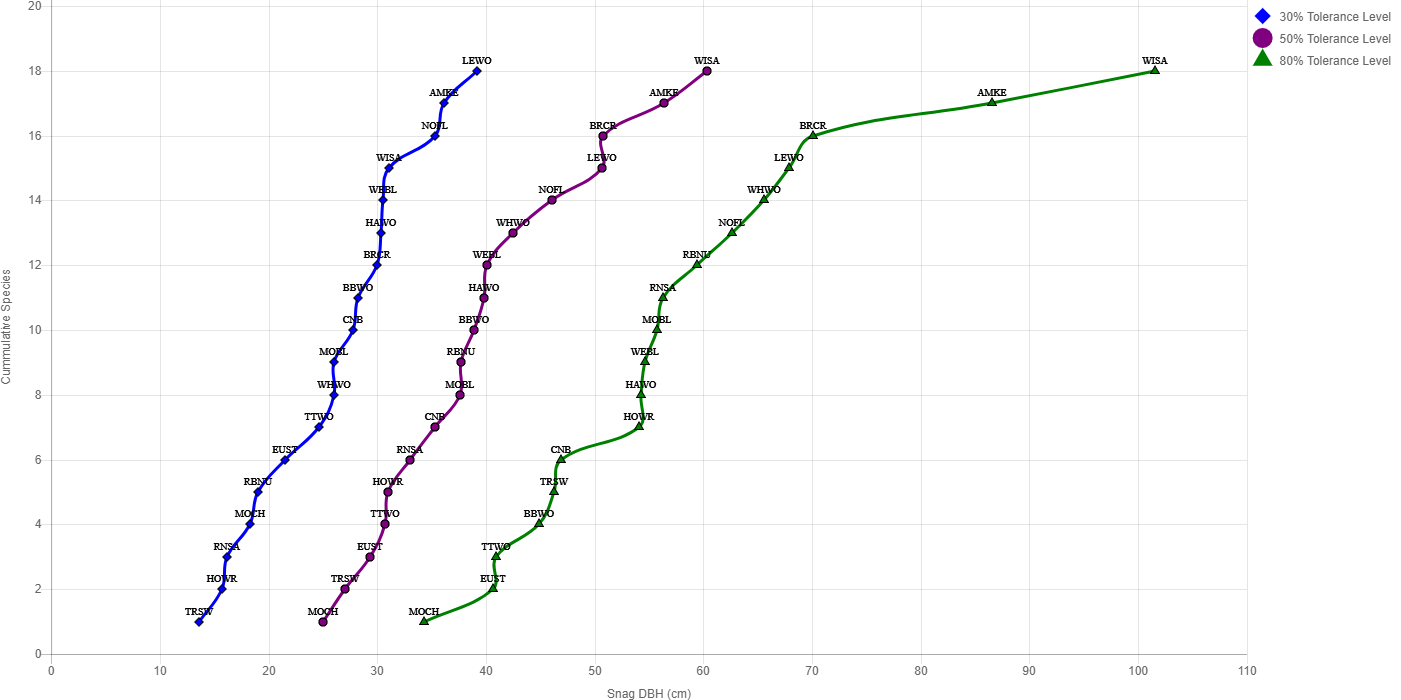
Table EMC_ECB_M.inv-1. Distribution of snag sizes on unharvested forest inventory plots (n=754) in the EMC_ECB_M Vegetation Condition.
| Snag dbh (cm) | % snags (> 25.4 cm) in size class1 | % of area with snags in size class2 |
|---|---|---|
| < 25.42 | N/A | 21 |
| 25.4 - 49.9 | 77 | 63 |
| 50 - 79.9 | 20 | 45 |
| ≥80 | 4 | 36 |
Other data indicate the importance of retaining and recruiting tall snags for roosting bats and pileated woodpeckers (Ancillary Data Figure EMC.sp-8).
Figure EMC.sp-8. Mean height of trees and snags used by wildlife species or groups in Eastside Mixed Conifer Forest Wildlife Habitat Type. Tree heights are weighted means for trees and snags across studies with the same species and tree use.
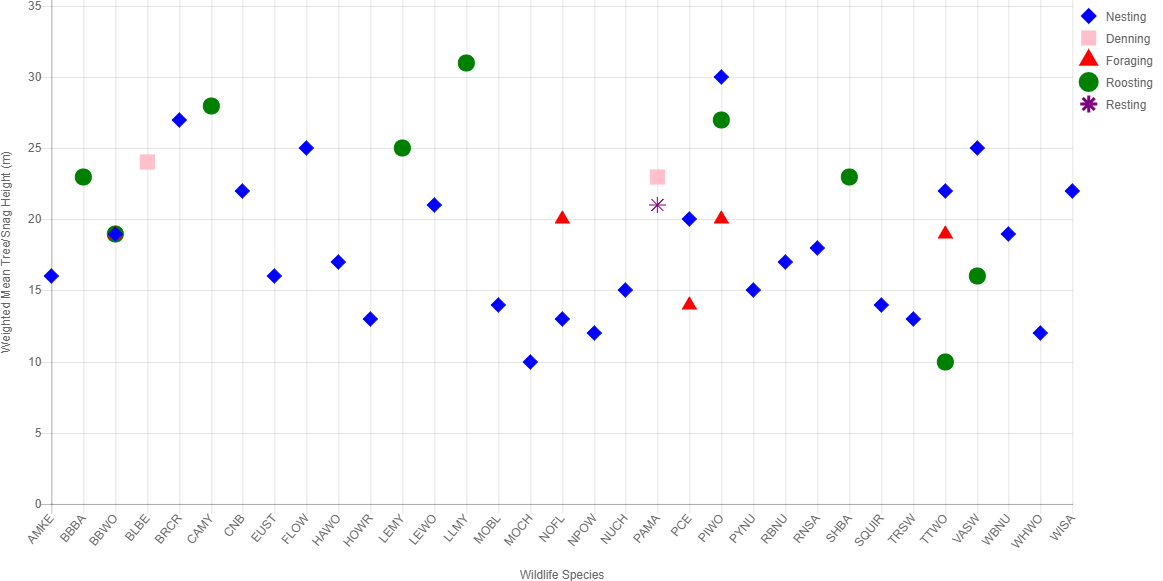
Data showing which trees species are used by snag associated wildlife are also available (Table EMC.sp-10, Figure EMC.sp-9). This information can be used to determine priority snag or down wood species to emphasize in dead wood retention guidelines.
Figure EMC.sp-9. Number of wildlife species or groups using different tree/snag species in Eastside Mixed Conifer Forest Wildlife Habitat Type.
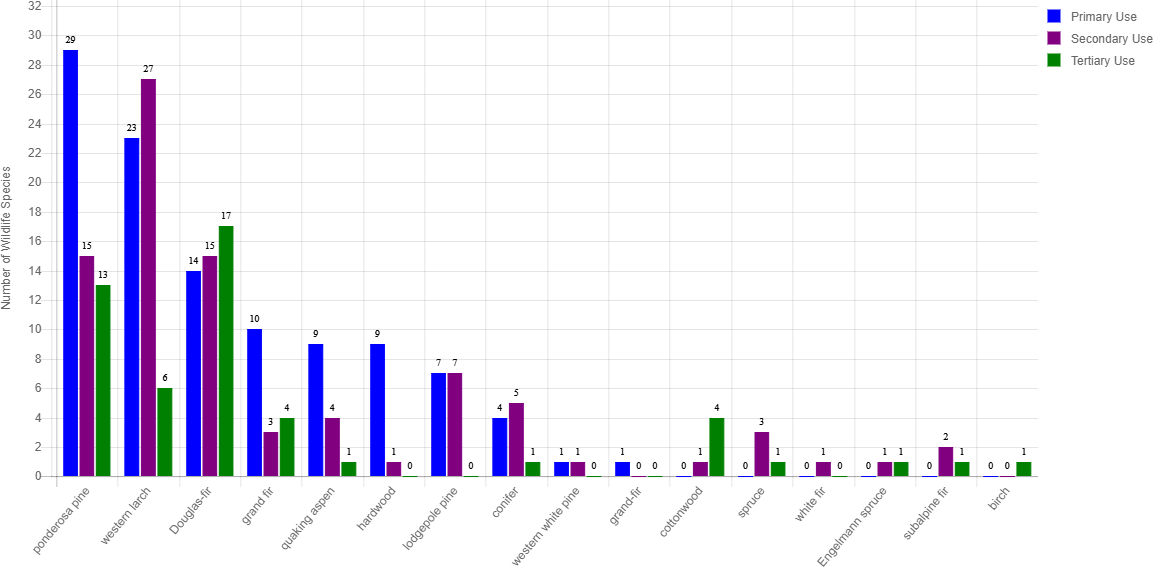
There is additional discussion on the importance of hollow trees and logs to a variety of wildlife species. They are especially important roosting and denning structures which take centuries to develop, thus they are important to protect where they exist.
There is a discussion in the Summary Narratives under the section: Considerations for developing, creating and retaining decayed wood elements, which also provides some valuable information that can assist in developing dead wood retention guidelines and marking guidelines.
Step 7:Discuss the "So What" Questions.
For Example:
- How well are wildlife species needs being met in the analysis area?
- If the species is dependent on large snags and the analysis area is deficient in large snags, how do you move towards getting more? What kind of effect does this have on this wildlife species?
- Is there the need or desire to move part of the landscape towards increasing the wildlife tolerance level for a wildlife species?
- How do the alternatives compare in terms of providing habitat now and in the future?
Snag densities and down wood percent cover are often higher at sites used by wildlife than would be indicated by the use of inventory data alone. Wildlife species may be selecting for clumps of snags around nest sites, dens, etc. which are areas represented by the wildlife species data. These higher density clumps (in relation to inventory data) need to be provided somewhere on the landscape. The vegetation inventory distribution histograms (from unharvested plots) can give clues as to what proportion of the landscape would be expected to provide these high density clumps snags. Graphs like Figure 1 above, are a good way to display which snag density classes may be in excess or deficient on the landscape and which species are affected.
Species home range information, combined with the inventory distribution data, can help determine number and sizes of patches of various snag densities distributed across the landscape that will provide high quality habitat. In this way prescriptions and project design can better accommodate species habitat provisions.
References
Bagne, Karen E., Kathryn L. Purcell, John T. Rotenberry. 2008. Prescribed fire, snag population dynamics, and avian nest site selection. Forest Ecology and Management 255:99-105.
Bate, Lisa J.; Garton, Edward O.; Wisdom, Michael J. 1999. Estimating snag and large tree densities and distributions on a landscape for wildlife management. Gen. Tech. Rep. PNW-GTR-425. Portland, OR: U.S. Department of Agriculture, Forest Service, Pacific Northwest Research Station. 76 p.
Mellen-McLean, Kim, Bruce G. Marcot, Janet L. Ohmann, Karen Waddell, Susan A. Livingston, Elizabeth A. Willhite, Bruce B. Hostetler, Catherine Ogden, and Tina Dreisbach. 2012. DecAID, the decayed wood advisor for managing snags, partially dead trees, and down wood for biodiversity in forests of Washington and Oregon. Version 2.2. USDA Forest Service, Pacific Northwest Region and Pacific Northwest Research Station; USDI Fish and Wildlife Service, Oregon State Office; Portland, Oregon. http://www.fs.fed.us/r6/nr/wildlife/decaid/